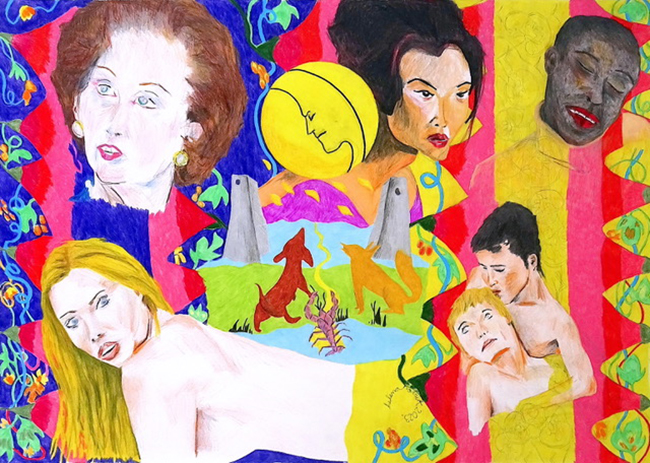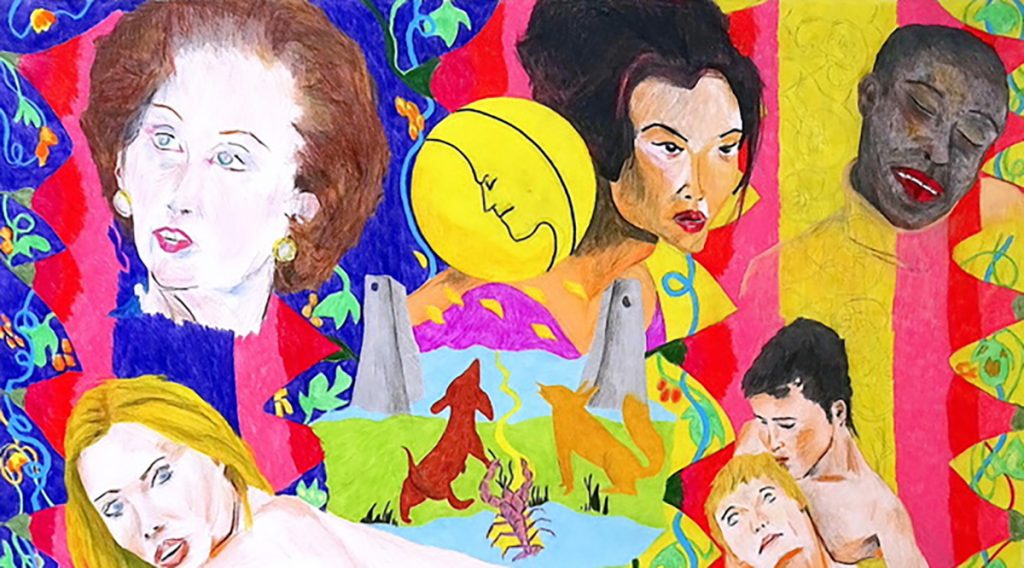Helena Kotnik, a Barcelona University and Akademie der bildende Künste, Vienna graduate, is an artist whose works are often described as “psychological human landscapes.” Her paintings, characterized by their colorful and somewhat naïve style, delve into the complexities of human society and the world we live in. Influenced by a variety of artists from different periods in art history, Kotnik’s paintings serve as a commentary on contemporary issues.

Kotnik’s artistic approach is a blend of vivid colors and straightforward forms, making her work accessible yet profoundly reflective. Her painting titled “Women” is a perfect example of this. Using pencil colors and pencil on paper, Kotnik creates a piece that measures 70 x 50 cm. This artwork is inspired by women and aims to portray them with their dreams, fears, beliefs, and authenticity. Each figure in the painting speaks for herself, inviting viewers to listen to their stories.
“Women” is more than just a collection of images; it’s a tapestry of individual expressions. Kotnik uses her pencil colors to craft images that, at first glance, might seem simple and naïve. However, upon closer inspection, the depth of each woman’s persona becomes evident. The artwork is a compilation of small images placed next to each other, creating a mosaic of female experiences.
Kotnik’s intention with this piece is clear: she wants viewers to see themselves in these women. The dreamlike quality of the images invites introspection. The fears and beliefs depicted are universal, yet each woman’s authenticity shines through, making the piece relatable on a personal level. There isn’t a single narrative but rather a collection of moments and feelings, each contributing to the overall experience of the painting.
Helena Kotnik draws inspiration from a wide range of artists across different periods. This eclectic mix of influences is evident in her work, where she combines elements from various styles to create something uniquely her own. Her use of vibrant colors can be seen as a nod to the Fauvist movement, while the simplicity and directness of her forms might remind one of folk art traditions.
Kotnik’s paintings are more than just aesthetically pleasing; they are a commentary on contemporary issues. Her focus on psychological human landscapes allows her to explore themes such as identity, society, and the human condition. Through her art, Kotnik addresses these themes in a way that is both engaging and thought-provoking.
In “Women,” for example, Kotnik addresses the role and perception of women in society. By portraying women with their dreams and fears, she challenges the viewer to consider these aspects in their own lives and in the lives of those around them. This focus on personal experience and authenticity is a recurring theme in her work, reflecting her belief in the importance of individual stories and perspectives.
One of the aspects of Kotnik’s work is its ability to connect with viewers on a personal level. Her paintings invite viewers to see themselves in her subjects, creating a sense of empathy and understanding. This connection is particularly strong in “Women,” where the individual stories and expressions of the women depicted resonate with viewers’ own experiences.
Kotnik’s work encourages viewers to look beyond the surface and consider the deeper meanings and themes. This introspective quality is a key element of her style, making her work both engaging and thought-provoking. By presenting complex themes in a straightforward and accessible way, Kotnik invites viewers to explore these themes in their own lives.
Helena Kotnik is an artist who blends simplicity and complexity in her work. Her colorful and somewhat naïve style belies the depth of her themes, allowing her to explore psychological human landscapes in a way that is both accessible. Through her paintings, Kotnik addresses contemporary issues and personal experiences, inviting viewers to see themselves in her work.
Her piece “Women” exemplifies this approach, using pencil colors and simple forms to create a tapestry of female experiences. Each woman’s story is unique, yet collectively they speak to universal themes of dreams, fears, and authenticity. Kotnik’s ability to connect with viewers on a personal level makes her work both engaging and meaningful, offering a fresh perspective on the complexities of human society.


